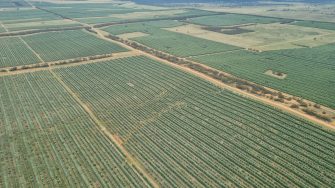
Date: Monday, October 26, 2020
Project: Eastern Australian Waterbird Survey
Observers: John Porter UNSW/DPIE, Richard Kingsford UNSW
Pilot: James Barkell NSW National Parks & Wildlife Service DPIE
This week we were surveying the River Murray. I started the morning in a different counting position, as left back observer or LBO, not the navigator. John took on the more challenging job of navigating as well as counting, as RFO or right front observer.
We left a very wet Sydney and headed into the clouds to fly on instrument flight rules or IFR, hoping that the clouds would have lifted west of the Great Divide. Thankfully, the weather had cleared quite a bit by the time we got to the top end of the Murray, just west of Albury.
Our first stop was Lake Mulwala which is the large weir pool caused by Yarrawonga Weir across the River Murray. All of the trees that used to be along the River Murray here are dead because they were waterlogged. As usual, it didn't have that many waterbirds but a small pelican colony on one of the islands was firing with quite a few pairs of birds nesting. Ducks were in short supply but there were a few black swans and cormorants.
The next major wetland on our list was the Ramsar-listed, Barmah-Millewa Forest, a wetland of international importance. This extensive river redgum forest has various swamps, lagoons and lakes up the western and southern end. We started surveying the forest at its most easterly point where there was only water in the main channel. As we got more towards the western boundary there was flooding distributed among trees, going out into the lagoons, swamps and lakes which were about 80% flooded.
We zig zagged across the forest to each of these lagoons counting the waterbirds. There weren’t nearly as many waterbirds in this system this year as in previous years. This often happens as the birds head off inland where the wetlands are more productive with their newly flooded areas. We saw nothing like the density of waterbirds that we’d seen on the Lachlan or Paroo River a couple of weeks ago.
There were a few white ibis, egrets, pelicans and the odd black duck and musk duck but generally only in the 10s for a particular lagoon. In total there were probably only 100s of waterbirds across the entire system.
Unlike in previous years we had to make some changes to our normal route down the River Murray. We usually stop the first night in Mildura. But obviously with Covid restrictions in Victoria, we needed a Plan B. This meant that we refuelled at Deniliquin, just north of the Barmah-Millewa Forest. We then flew across to Mildura and its irrigated areas, stretching in every direction.
We couldn’t get down to the survey the River Murray at Wentworth, as the weather had closed in with sweeping low cloud and drizzle. These conditions were impossible for waterbird surveys, given the poor visibility and danger for a low flying plane. So we headed to Renmark in South Australia, knowing that we need to pick up some time the following day to get the survey done, when hopefully the drizzle and low clouds had moved through. As soon as we arrived, we were required to check in our approval details with the South Australian police, as new visitors from NSW, which we duly did. And then this was followed up by a visit to our motel by the police about an hour later to check up on us in a very friendly and professional manner. It’s good to see these processes operating so well on the ground and keeping us all as COVID safe as possible.
Blog by Richard Kingsford
